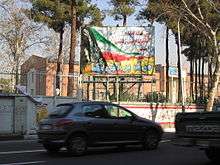Embassy of the United States, Tehran
| Embassy of the United States, Tehran | |
|---|---|
|
Native name Persian: سفارت ایالات متحده آمریکا، تهران | |
|
Defaced Great Seal of the United States | |
| Location |
|
| Coordinates | 35°42′29″N 51°25′27″E / 35.708056°N 51.424167°ECoordinates: 35°42′29″N 51°25′27″E / 35.708056°N 51.424167°E |
| Opened | 1951 |
| Closed | 1979 |
| Ambassador |
Loy W. Henderson (first) Bruce Laingen (last) |
 Location of Embassy of the United States, Tehran in Iran | |
The Embassy of the United States of America in Tehran was the United States of America's diplomatic mission in the Imperial State of Iran. Direct bilateral diplomatic relations between the two governments were severed following the Iranian Revolution in 1979, and the subsequent seizure of the embassy in November 1979.[1][2]
History

The embassy was designed in 1948 by the architect Ides van der Gracht, the designer of the Embassy of the United States in Ankara. It was a long, low two-story brick building, similar to American high schools built in the 1930s and 1940s. For this reason, the building was nicknamed "Henderson High" by the embassy staff, referring to Loy W. Henderson, who became America's ambassador to Iran just after construction was completed in 1951.[3]
The US diplomatic mission has been defunct and the building has not been used by the U.S. since the Iran hostage crisis of 1979.[1][2] Since then, the United States government has been represented in Iran by the United States Interests Section of the Embassy of Switzerland in Tehran.[4] The name currently given to the compound by many Iranians is variously translated as "espionage den," "den of espionage", and "nest of spies".[1][5]
After the fall of the embassy, the Revolutionary Guard used it as a training center, and continue to maintain the complex.[6] The brick walls that form the perimeter (the embassy grounds are the size of a city block) feature a number of anti-American murals commissioned by the government of Iran.[6] The site has also housed a bookstore and a museum (both are closed to foreigners and the general Iranian public, though exceptions do exist.[7]). The Great Seal of the United States is badly damaged, but still visible at the entryway.
The Muslim Student Followers of the Imam's Line published documents seized in the embassy (including painstakingly reconstructed shredded documents) in a series of books called "Documents from the US Espionage Den" (Persian: اسناد لانه جاسوس امریكا Asnāde lāne jasusi Amrikā).[8] These books included telegrams, correspondence, and reports from the United States Department of State and Central Intelligence Agency, some of which remain classified to this day.
Former Iranian Embassy
The Former Embassy of Iran in Washington, D.C. is also defunct as Iran does not currently have an embassy in the United States. Its interests are handled through the Interests Section of the Islamic Republic of Iran in the United States at the Pakistan Embassy in Washington D.C.
See also
- Iran hostage crisis
- Iran–United States relations
- United States Ambassador to Iran
- Embassy of the United Kingdom, Tehran
- American School in Tehran
References
| Wikimedia Commons has media related to Embassy of the United States in Tehran. |
| Wikisource has original text related to this article: |
- 1 2 3 "Former American Embassy in Iran Attracts Pride and Dust". New York Times. 2013-10-31.
- 1 2 "http://www.cnn.com/2014/01/30/politics/iran-embassy-mistrust/". CNN. 2014-01-30. External link in
|title=(help) - ↑ The architecture of diplomacy: building America's embassies ADST-DACOR diplomats and diplomacy series. Jane C. Loeffler. Publisher Princeton Architectural Press, 1998. ISBN 1-56898-138-4 pp.56
- ↑ Embassy of Switzerland in Iran - Foreign Interests Section, Swiss Federal Department of Foreign Affairs (page visited on 4 April 2015).
- ↑ Federation of American Scientists on the Espionage Den
- 1 2 "The Great Satan's Old Den: Visiting Tehran's U.S. Embassy". TIME. 2009-07-14.
- ↑ Inside The Former US Embassy In Tehran, Iran
- ↑ Documents from the U.S. Espionage Den
External links
- The Memory Hole at the Wayback Machine (archived May 13, 2010) hosts a gallery of photographs taken from inside the US Embassy during the crisis.
- The Memory Hole at the Wayback Machine (archived March 29, 2006) 400 Pages of Still-Classified CIA and State Dept Documents Seized From the US Embassy in Tehran.
- متن کامل و تحلیل اسناد لانه جاسوسی آمریکا (The Full Text and Analysis of the Documents from the US Espionage Den)
- Inside The Former US Embassy In Tehran, Iran
- Documents from the U.S. Espionage Den
- Contemporary photograph of the embassy gates (on flickr)
- Embassy of Switzerland - Foreign Interests Section
- U.S. Department of State page for Iran
- Virtual Embassy of the United States, Tehran (not a physical presence in Iran)
